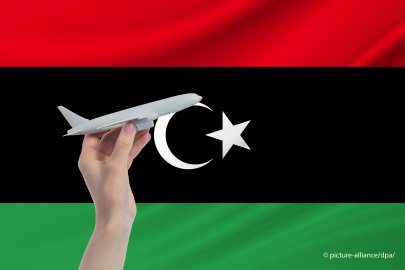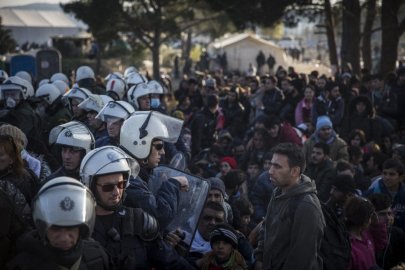Leaving Libya: Syrian and Bangladeshi nationals fly back to their home countries
Source: InfoMigrants: reliable and verified news for migrants – InfoMigrants
After years of living in Libya, 152 Syrian and 309 Bagladeshi nationals are flying back home as part of voluntary return programs.
The International Organization for Migration (IOM) announced that 152 Syrian nationals were flown back to their homeland from Libya on October 09, reporting that it had facilitated the Voluntary Humanitarian Return (VHR) flight at the request of the Syrian Ministry of Foreign Affairs and Expatriates.
The passengers, who were described as families who had been living in Libya for over a decade, departed from the Libyan capital of Tripoli, where they were given pre-departure assistance.
Upon arrival in Syria, the passengers received reception and transportation assistance to take them to their final destinations — primarily the cities of Aleppo, Hama, and Homs.

IOM operating in Syria again
In July, the Ministry of Foreign Affairs and Expatriates issued its formal approval to re-establish IOM presence in Damascus and expand humanitarian operations across the country in July.
“IOM is expanding its operations and services in Syria with the primary objective of supporting the country’s recovery after years of conflict and ensuring dignified and sustainable returns of Syrians — whether displaced internally or returning from abroad,” said Othman Belbeisi, director of the IOM regional office for the Middle East and North Africa, in a statement.
In partnership with authorities, IOM is now planning to launch a two-year project in return areas like Aleppo to support the shelter and reintegration needs of those newly returned to Syria. The IOM’s Displacement Tracking Matrix (DTM) lists an estimated 581,000 Syrians who have returned to Syria from abroad since the fall of the Assad Regime in December 2024.
Most of the returnees are reportedly mainly from Turkey and Lebanon.
Returning after the fall of Assad
The fall of the Assad Regime in December 2024 marked the end of the decades-long civil war that had triggered the diaspora of Syrians fleeing for safety.
While Germany hosts the largest number of Syrian nationals in the European Union, Turkey is the country hosting the largest number of Syrian refugees under temporary protection, numbering an estimated three million.
Lebanon, Jordan, Iraq, and Egypt had also become major destinations for Syrian nationals during the war.
However, the restive peace that has followed the Assad’s fall has created new challenges for many Syrians who either have nothing left to return to or are unable to go back.
As Europe rushes to revise asylum policies which once welcomed Syrians at the height of the conflict, it is now intensifying efforts to push them toward returning home.
Elsewhere — such as Libya — rights activists argue that these returns often occur under pressure, with reports of arbitrary detention being used as a psychological tactic to compel refugees into signing “voluntary” repatriation documents.

Read Also
UNHCR calls for more aid to support Syrians returning home
Hundreds of returns to Bangladesh
The Bangladeshi embassy in Libya meanwhile reported that 309 Bangladeshi citizens were also voluntarily returning from Tripoli the same day, and were expected to arrive in Bangladesh today.
Kazi Asif Ahmed, Charge d’Affaires, said that the embassy was working closely with the Libyan government to repatriate more than six hundred migrants to the country through two more flights in the near future.
Since 2017, Bangladeshi migrants have consistently ranked among the top nationalities to cross the Mediterranean Sea to Europe, which is considered one of the most dangerous migration routes in the world.
In the first trimester of 2024, Bangladeshis represented the third-most common nationality to make the crossing, after Mali and Senegal.
IOM data indicates that there were an estimated 21,134 Bangladeshi nationals in the country between March and May 2024. Bangladeshis represent about three percent of all migrants in Libya.
Bangladeshi nationals in Libya are typically between the ages of 20-39, male, and unmarried, according to the IOM, with about two thirds of them having a work permit to work there — typically as construction laborers, cleaners, or waiters.

Because of its geographic location and years of lawlessness since the fall of Libyan dictator Muammar Gaddhafi, the North African nation has long become a main departure point for people who want to attempt to come to Europe using irregular means, typically entering via Italy or, less commonly, Greece.
Many of those who brave the perilous journey and are intercepted at sea by Libya’s coast guard end up in detention in Libya.
The UN Refugee Agency (UNHCR) has repeatedly called for the release of refugees and migrants who are being held arbitrarily in Libya under inhuman conditions, with reports of abuse, violence, slavery, rape, extortion and murder rife across Libya.
Read Also
The stories Bangladeshi migrants told on a rescue ship in the Mediterranean
The original article: belongs to InfoMigrants: reliable and verified news for migrants – InfoMigrants .




